Printing Business Plan Template & PDF Example

Creating a comprehensive business plan is crucial for launching and running a successful printing business. This plan serves as your roadmap, detailing your vision, operational strategies, and financial plan. It helps establish your printing business’s identity, navigate the competitive market, and secure funding for growth.
This article not only breaks down the critical components of a printing business plan, but also provides an example of a business plan to help you craft your own.
Whether you’re an experienced entrepreneur or new to the service industry, this guide, complete with a business plan example, lays the groundwork for turning your printing business concept into reality. Let’s dive in!
The Plan
Our printing business plan is meticulously developed to incorporate all vital elements essential for a comprehensive and strategic blueprint. It outlines the company’s operational workflows, marketing tactics, industry landscape, competitive analysis, management hierarchy, and financial outlook.
- Executive Summary: Offers a concise overview of the printing business concept, highlighting the market analysis, management expertise, and financial strategy.
- Business Overview: This section delves into the details of the printing business’s operational framework and service offerings, establishing a foundation for its market operations.
- Facility & Operations: Discusses the location, size, and layout of the printing facility, including the types of printing equipment and technology used to provide services.
- Services & Prices: Details the range of printing services offered, such as digital, offset, and large format printing, along with pricing strategies.
- Market Overview: Provides an in-depth analysis of the printing industry, identifying the company’s position within this competitive landscape.
- Key Stats: Offers statistics on the size and growth of the commercial printing industry, underscoring the ongoing demand for printing services.
- Key Trends: Highlights significant trends in the printing industry, including technological advancements, sustainability practices, and shifts towards digital printing.
- Key Competitors: Evaluates major competitors in the market, detailing their services and how the printing company differentiates itself from these competitors.
- Strategy: Outlines the strategic framework the printing company will employ to navigate the industry and achieve its business objectives.
- SWOT Analysis: Conducts a comprehensive analysis of strengths, weaknesses, opportunities, and threats, offering strategic insights for the company’s growth.
- Marketing Plan: Specifies the marketing strategies designed to promote the printing services and establish long-term relationships with clients.
- Timeline: Sets key milestones for the printing company, outlining the path from startup to expansion and operational excellence.
- Management: Introduces the management team, highlighting their experience, roles, and contributions to driving the company towards its goals.
- Financial Plan: Forecasts the 5-year financial performance of the printing company, detailing expected revenue streams, profitability, and the financial strategy to ensure sustainability and growth.
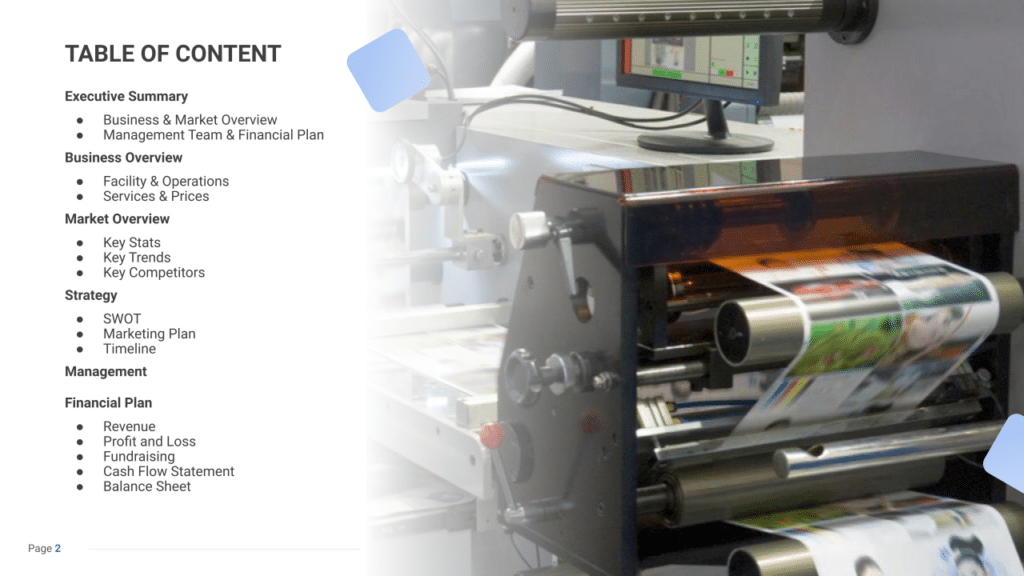
Executive Summary
The Executive Summary introduces your printing business’s plan, providing a succinct overview of your company and its offerings. It should outline your market positioning, the variety of printing services you provide, including digital printing, large format printing, and specialized printing solutions, as well as its location, size, and a snapshot of daily operations.
This section should also delve into how your printing business will fit into the local market, including the number of direct competitors in the area, identifying who they are, along with your business’s unique selling points that set it apart from these competitors.
Moreover, information about the management and co-founding team should be included, detailing their roles and contributions to the business’s success. Additionally, a summary of your financial projections, including revenue and profits over the next five years, should be presented.
Printing Business Plan Executive Summary Example

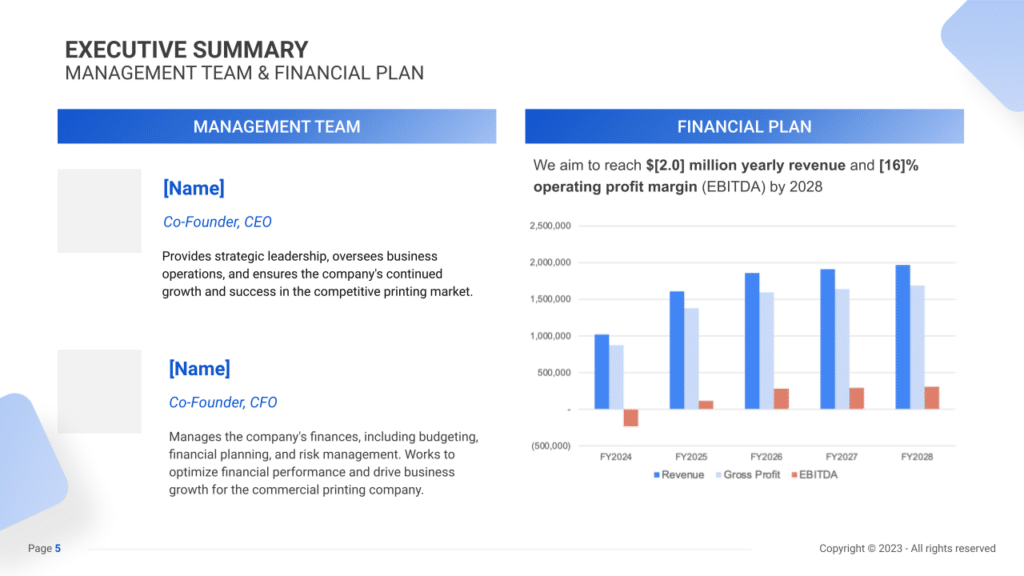
Business Overview
In your executive summary’s business overview, provide clear and concise information about your printing business. This includes the name of your company, the location of your facility, the technology you use, and a brief overview of your operations.
Detailing these aspects not only introduces your business but also sets the stage for showcasing its unique attributes. Your Unique Selling Proposition (USP) should be highlighted here, whether it’s your cutting-edge printing technology, wide range of services, or commitment to sustainability. Your USP is what captures the attention of your audience and showcases the unique value your business brings to the commercial printing industry.
Example:
“Print Innovations Ltd.,” located in the heart of Silicon Valley, operates a 10,000 sq. ft. state-of-the-art printing facility equipped with advanced digital and offset printers and finishing equipment. Our USP lies in our ability to provide rapid, high-quality printing solutions, from small customized orders to large-scale commercial projects, all while adhering to eco-friendly practices.
Market Overview
The market overview should provide a snapshot of the commercial printing industry’s size, growth trends, and key dynamics. Using data such as market value and growth rates can help paint a picture of the industry landscape. Discussing trends like the shift towards digital printing and sustainable practices can offer insights into the industry’s future and your company’s role within it.
The competitive landscape is also critical. This part should identify your main competitors and explain how your service distinguishes itself, whether through innovative solutions, superior quality, customer service, or environmental initiatives.
Example:
Print Innovations is part of the $162 billion U.S. commercial printing industry, expected to grow at a 2.8% CAGR through 2030. Despite stiff competition, our company sets itself apart with its emphasis on digital innovation and sustainability, offering environmentally friendly printing options that appeal to a growing segment of eco-conscious customers.
Management Team
The expertise and background of your management team are significant assets to your business. Highlight the key qualifications and experiences of your team members, emphasizing the industry knowledge and leadership driving your business.
Example:
Led by co-founders Alex Johnson and Taylor Smith, Print Innovations benefits from a blend of entrepreneurial spirit and industry expertise. Alex, with over 15 years in digital printing technology, and Taylor, an expert in sustainable business practices, combine their strengths to position Print Innovations as a leader in innovative and eco-friendly printing solutions.
Financial Plan
Your financial plan should succinctly summarize your financial objectives and projections, including revenue targets and profit margins, to provide a clear picture of your printing business’s financial future.
Example:
Print Innovations aims to achieve $2 million in annual revenue by 2028, targeting a 16% EBITDA margin. Our financial strategy focuses on expanding our service offerings and leveraging the latest printing technologies to increase efficiency and reduce costs, positioning us for sustained growth and profitability in the competitive printing industry.
Business Overview
For a printing business, the Business Overview section can be efficiently divided into 2 main parts:
Facility & Operations
Briefly describe the physical setup of your printing facility, emphasizing its design, efficiency, and the technology-driven environment that ensures high-quality printing services. Mention the business’s location, highlighting its accessibility and the convenience it offers to clients, such as proximity to business districts or ease of delivery and pickup services. Explain why this location is advantageous in attracting your target clientele, including businesses, professionals, and retail customers.
Services & Pricing
Detail the range of printing services offered, from standard document printing to specialized services like large format printing, custom merchandise printing, and high-quality digital printing solutions. Outline your pricing strategy, ensuring it reflects the quality of printing services provided and matches the market you’re targeting. Highlight any bulk order discounts, business account deals, or loyalty programs that provide added value to your clients, encouraging repeat business and customer loyalty.


Market Overview

Industry size & growth
In the Market Overview of your printing business plan, start by examining the size of the printing industry and its growth potential. This analysis is crucial for understanding the market’s scope and identifying expansion opportunities.
Key market trends
Proceed to discuss recent market trends, such as the increasing demand for customized printing solutions, the growth in digital and 3D printing technologies, and the shift towards sustainable and eco-friendly printing practices. For example, highlight the demand for services that cater to specific customization needs, such as personalized marketing materials, custom packaging, and on-demand printing, alongside the rising popularity of green printing solutions.
Competitive Landscape
A competitive analysis is not just a tool for gauging the position of your printing business in the market and its key competitors; it’s also a fundamental component of your business plan.
This analysis helps in identifying your printing business’s unique selling points, essential for differentiating your business in a competitive market.
In addition, the competitive analysis is integral in laying a solid foundation for your business plan. By examining various operational aspects of your competitors, you gain valuable information that ensures your business plan is robust, informed, and tailored to succeed in the current market environment.
Identifying Your Competitors in the Printing Industry
The initial step in conducting a competitive analysis is to pinpoint your competitors. Start by mapping out local print shops and digital printing services. If your business specializes in high-quality, custom print jobs, your direct competitors are other print shops that offer similar services, as well as larger online printing companies. Don’t forget about indirect competitors like office supply stores that offer basic printing services.
Utilize online resources such as Google Maps to understand the geographical distribution of your competitors. Websites like Yelp and TripAdvisor can provide customer reviews and ratings, offering insights into the strengths and weaknesses of these competitors. For instance, if multiple reviews highlight the quick turnaround and high-quality prints at “PrintPro Services,” this indicates a significant strength of that competitor.
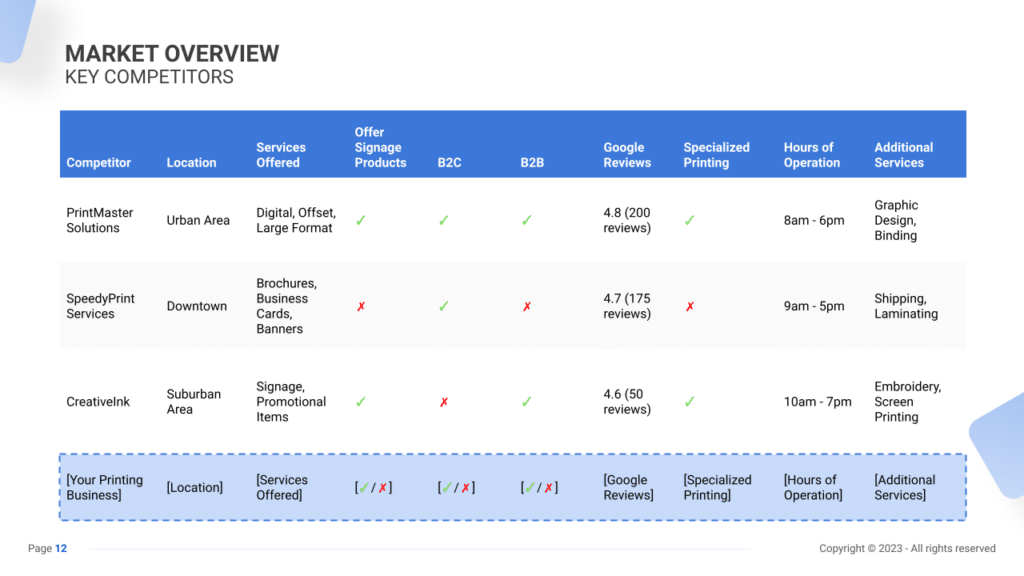
Analyzing Competitors’ Strategies in the Printing Business
Evaluating your competitors’ strategies involves looking at various factors:
- Product Offerings: Analyze the range of printing services offered. If “EcoPrint Solutions” is becoming popular for its sustainable printing options, it suggests a market trend toward environmentally friendly printing services.
- Printing Technology: Consider the technology and methods used. A company like “Precision Prints” that employs state-of-the-art digital printing technology may cater to a different clientele than a shop like “Retro Print Studio,” known for traditional screen printing techniques.
- Pricing Strategy: Compare your pricing with that of competitors. Are your services priced competitively with “Budget Print Hub,” or do they align more with the high-end services of “Luxury Print Works”?
- Marketing Strategies: Observe how competitors market their services. Do they have a significant online presence, or do they focus more on B2B relationships and networking within specific industries?
- Customer Service: Evaluate the level of customer service provided. For example, “Friendly Printers” might be renowned for its exceptional customer support and personalized service, which enhances the overall customer experience.
- Operational Efficiency: Look at whether competitors are leveraging technology or innovative processes to improve their service delivery, such as “Streamline Prints” with its efficient online ordering and tracking system.
What’s Your Printing Business’s Value Proposition?
Reflect on what makes your printing business unique. Perhaps you offer unparalleled quality and precision in large-format printing, or maybe you provide a wide range of customizable printing options that aren’t available from other local providers.
Identify gaps in the market through customer feedback and industry trends. For instance, the increasing demand for eco-friendly and sustainable printing options might represent an opportunity if your competitors have yet to address this need adequately.
Consider your business location: A printing business in a commercial district may focus on corporate and B2B services, while one in a university area could cater to academic printing needs, offering specialized services such as thesis and project printing.
Strategy

SWOT
First, conduct a SWOT analysis for the printing business, highlighting Strengths (such as advanced printing technology and a broad range of printing services), Weaknesses (including reliance on equipment that may require costly maintenance or the challenge of adapting to rapidly changing technology), Opportunities (for example, the growing demand for personalized and on-demand printing services), and Threats (such as digital media alternatives reducing the need for traditional printing).
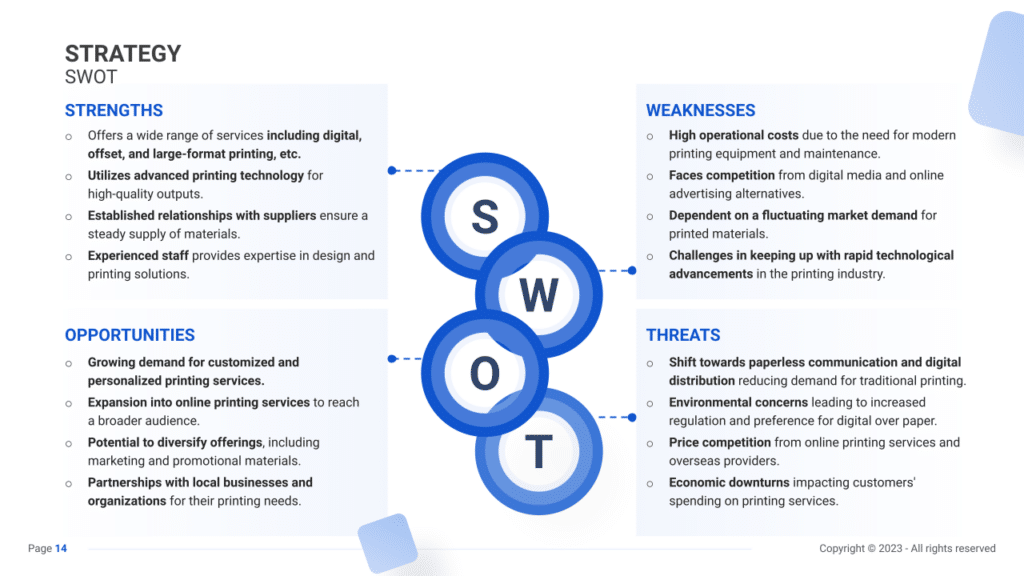
Marketing Plan
Next, develop a marketing strategy that outlines how to attract and retain customers through targeted advertising, promotional offers, an engaging online presence, and partnerships with local businesses. Emphasize the importance of showcasing your unique capabilities, such as high-quality printing, fast turnaround times, or eco-friendly printing options, to differentiate your business from competitors.
Marketing Channels
Effectively utilizing various marketing channels is key to reaching potential clients and enhancing brand visibility:
Digital Marketing
- Website Optimization: Create a user-friendly website that not only showcases your services but also offers resources, such as downloadable print templates, industry insights, and FAQs. Optimize it for SEO to improve online visibility.
- Content Marketing Strategies: Produce informative and engaging content, such as blog posts, infographics, or video tutorials, addressing common printing queries, emerging trends, and case studies showcasing successful projects.
Social Media Engagement
- Platform Selection: Identify the most suitable social media platforms for your business. LinkedIn is effective for B2B outreach, while Instagram and Pinterest can showcase visually appealing print designs and creative concepts.
- Engagement and Interaction: Regularly engage with your audience by responding to comments, sharing user-generated content, and hosting interactive sessions like live Q&A sessions or design challenges.
Local Networking and Advertising
- Networking Events and Partnerships: Participate in local business networking events, industry conferences, and trade shows to establish connections, build partnerships, and generate leads.
- Local Advertising Strategies: Consider investing in targeted local print ads in newspapers, and magazines, or sponsoring community events or local sports teams to boost brand visibility within your immediate vicinity.
Promotional Activities
Attracting and engaging clients through compelling offers and initiatives:
Introductory Offers
- Discounts and Bundled Deals: Offer first-time client discounts or package deals for bulk orders to entice new clients to experience your services at a reduced cost.
- Seasonal Promotions: Launch seasonal promotions like “Back-to-School Printing Specials” or “Holiday Greeting Card Packages” tailored to current market needs and trends.
Referral Programs
- Incentivizing Referrals: Encourage satisfied clients to refer others by providing them with discounts, free add-ons, or credits on their next order for successful referrals.
- Client Testimonials and Case Studies: Highlight satisfied client testimonials and case studies showcasing successful projects on your website and marketing materials to build credibility and trust.
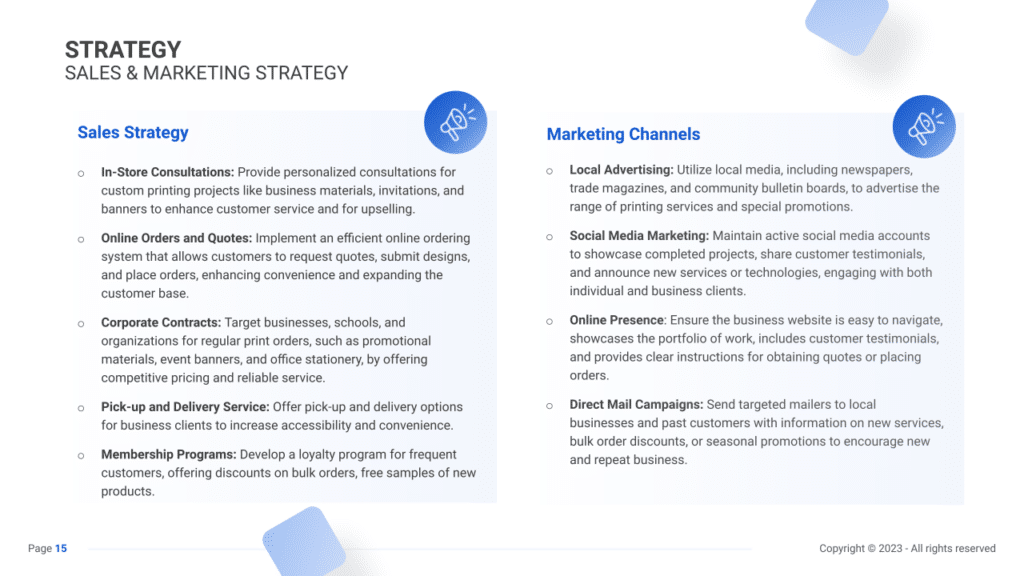
Sales Channels
Optimizing sales channels to maximize revenue streams and customer satisfaction:
Online Ordering System
- Seamless User Experience: Ensure a seamless online ordering system on your website, allowing clients to easily request quotes, upload files, track orders, and make payments securely.
- E-commerce Integration: Integrate an e-commerce platform into your website to sell printing-related products like custom stationery, promotional items, or design templates directly to clients.
Client Engagement Strategies
- Upselling and Consultative Selling: Train your sales team to upsell by suggesting additional services, premium finishes, or design consultations tailored to each client’s specific needs and project requirements.
- Exceptional Customer Support: Provide personalized and prompt customer service, guiding clients through the printing process, offering expert advice, and ensuring satisfaction with every interaction.
Membership and Loyalty Programs
- Tailored Membership Plans: Introduce membership options offering discounts on recurring orders, bulk printing, or exclusive access to new services or products.
- Rewarding Loyalty: Develop a robust loyalty program where clients earn points for every purchase, which they can redeem for discounts or exclusive offers on future orders.
Strategy Timeline
Finally, create a detailed timeline that outlines critical milestones for the printing business’s launch, marketing initiatives, customer base growth, and expansion goals. This should include key phases such as establishing your facility, launching your website and online ordering system, initial customer acquisition efforts, and the evaluation of potential new services or technologies to keep your business at the forefront of the printing industry, ensuring the business progresses with clear direction and purpose.

Management
The Management section focuses on the printing business’s management and their direct roles in daily operations and strategic direction. This part is crucial for understanding who is responsible for making key decisions and driving the printing business toward its financial and operational goals.
For your printing business plan, list the core team members, their specific responsibilities, and how their expertise supports the business.


Financial Plan
The Financial Plan section is a comprehensive analysis of your financial projections for revenue, expenses, and profitability. It lays out your printing business’s approach to securing funding, managing cash flow, and achieving breakeven.
This section typically includes detailed forecasts for the first 5 years of operation, highlighting expected revenue, operating costs and capital expenditures.
For your printing business plan, provide a snapshot of your financial statement (profit and loss, balance sheet, cash flow statement), as well as your key assumptions (e.g. number of customers and prices, expenses, etc.).
Make sure to cover here
_ Profit and Loss
_ Cash Flow Statement
_ Balance Sheet
_ Use of Funds









